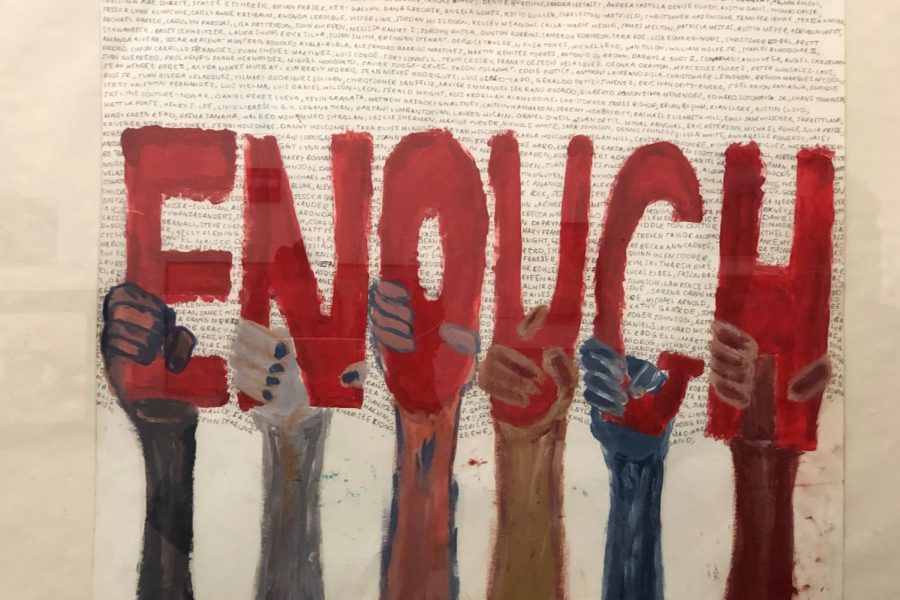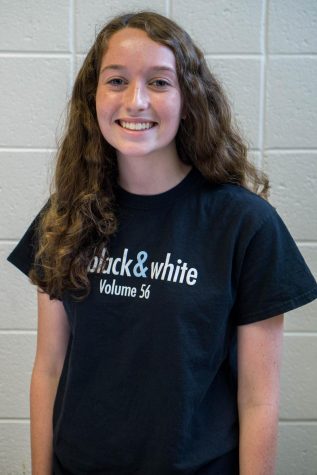Students combine art and activism in new “Walls of Demand” exhibit
February 18, 2019
As senior Alisha Dhir walked through the “Walls of Demand” exhibit in downtown D.C. last Tuesday, admiring the huge brick-wall murals, photographs and posters centered around youth promotion of gun control, she felt inspired. Walking past congresspeople and political activists alike, it was clear to her that everyone shared a common belief: the U.S. needs to protect its children.
The “Walls of Demand” exhibit opened at The Center for Contemporary Political Art Friday, Feb. 8, and is on display until March 15—a period coinciding with the Feb. 14 anniversary of the Parkland shooting. The exhibit includes pieces about gun control and other social issues by 16 Montgomery County students and artists Manuel Oliver and Margi Weir.
Student political association MoCo for Change spearheaded student participation in the exhibit; co-president Dani Miller received applications from students across the county and then submitted them to the exhibit for review. Freshman Karla Stephan worked with Miller as the Whitman representative of MoCo for Change and was in charge of recruitment for the gallery.
“From what I’ve seen of the art, it’s very raw and emotional,” Stephan said. “I hope that people who see these pieces realize that it’s an issue we fix now because people are dying from gun violence everyday.”
The display continues the art activism, or “artivism,” movement started by Manuel Oliver, the father of Parkland shooting victim Joaquin Oliver. Manuel has been creating murals as a way to memorialize Joaquin and to warn people immigrating to the U.S.—as he did himself—about gun violence.
Reps. Jamie Raskin and Joe Kennedy, Speaker of the House Nancy Pelosi and gallery coordinators spoke to a crowd of artists and guests about the artwork Feb. 12. The speakers stressed the importance of using art as a form of activism.
“I had to rush over from Capitol Hill—where I was with the powers that be—in order to be here with the powers that ought to be,” Raskin said.
Seniors Alisha Dhir, Sydney Maggin and Maya Valencia heard about the project from Stephan, and they all had pieces in the exhibit.
Valencia chose photography as her medium; her image depicts four elementary school aged girls holding empty posters, with the words “no one is listening” fading into the background and red lines covering all of the children’s mouths. Valencia feels the photograph represents the reality of the gun control movement: the government is failing to listen to the protests of the people.
“This movement started with Columbine and Sandy Hook, so incorporating students of that age made it a lot more powerful,” she said.
Maggin’s piece focused on commemorating all the victims of gun violence from the past 17 years. The painting—which doubled as her poster for the March 2018 student walkout—illustrates a line of hands held up in protest, each hand holding a letter to spell out “enough.” In the background, Maggin wrote the name of each person who has died from gun violence since the Columbine shooting in 1999.
“I wanted to get the message across that students are here to participate, because this isn’t an issue that’s going away,” Maggin said. “I also thought it was the perfect opportunity to give the people who lost their lives to gun violence a platform.”
Sixteen of the 19 student pieces centered around gun reform, but others addressed social issues like the disproportionate murder rate for transgender women and the importance of freedom of the press.
Dhir’s artwork focused on feminism and empowerment. Her digital composition highlighted multiple tenets of the feminist movement, including an equality sign, a hammer smashing through a glass ceiling and a bright pink uterus.
Maggin and Dhir were excited about getting to express their opinions in such a public, raw way. Maggin believes art has a powerful ability to resonate with people and convey a message.
“When you observe art, you see something and then feel a certain emotion,” Maggin said. “A lot of times, art can show the drastic impact that events can have on people, like gun violence, and that’s not something that can be easily portrayed in speeches.”
When the gallery closes, Miller said she wants artists and students to continue their political involvement. On March 14, one year after the first nationwide school walkout, MoCo Students for Change will lead another nationwide school walkout to demand that Congress pass HR-8, a bill aimed at making background checks for every firearm sale mandatory.
“It’s really important that people see this, they act, they do it for Joaquin and they do it for the 40,000 a year who die of gun violence,” Miller said.
Living so close to the capital, being passionate about politics is a given, Valencia said. But the ability to use art to spark conversations and promote awareness makes her feel like she’s truly “part of a bigger picture.”
“I love being able to use my art as a platform to address these issues,” Valencia said. “I feel like it gives me a purpose and gives my art a purpose. I’m not making it for myself and my enjoyment; I’m making it for a cause.”








